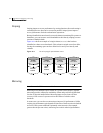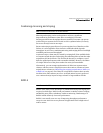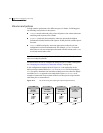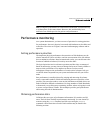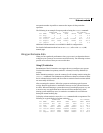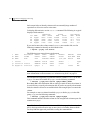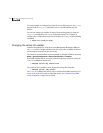
470 Performance monitoring and tuning
Performance monitoring
Such output helps to identify volumes with an unusually large number of
operations or excessive read or write times.
To display disk statistics, use the vxstat -d command. The following is a typical
display of disk statistics:
OPERATIONS BLOCKS AVG TIME(ms)
TYP NAME READ WRITE READ WRITE READ WRITE
dm mydg01 40473 174045 455898 951379 29.5 35.4
dm mydg02 32668 16873 470337 351351 35.2 102.9
dm mydg03 55249 60043 780779 731979 35.3 61.2
dm mydg04 11909 13745 114508 128605 25.0 30.7
If you need to move the volume named archive onto another disk, use the
following command to identify on which disks it lies:
# vxprint -g mydg -tvh archive
The following is an extract from typical output:
V NAME RVG/VSET/CO KSTATE STATE LENGTH READPOL REFPLEX UTYPE
PL NAME VOLUME KSTATE STATE LENGTH LAYOUT NCOL/WDTH MODE
SD NAME PLEX DISK DISKOFFS LENGTH [COL/]OFF DEVICE MODE
v archive - ENABLED ACTIVE 20480 SELECT - fsgen
pl archive-01 archive ENABLED ACTIVE 20480 CONCAT - RW
sd mydg03-03 archive-01 mydg03 0 40960 0 c1t2d0 ENA
Note: Your system may use device names that differ from these examples. For
more information on device names, see “Administering disks” on page 77.
The subdisks line (beginning sd) indicates that the volume archive is on disk
mydg03. To move the volume off mydg03, use the following command:
# vxassist -g mydg move archive !mydg03 dest_disk
Here dest_disk is the destination disk to which you want to move the volume. It
is not necessary to specify a destination disk. If you do not specify a destination
disk, the volume is moved to an available disk with enough space to contain the
volume.
For example, to move a volume from disk mydg03 to disk mydg04, in the disk
group, mydg, use the following command:
# vxassist -g mydg move archive !mydg03 mydg04
This command indicates that the volume is to be reorganized so that no part of it
remains on mydg03.
Note: The Veritas Enterprise Administrator (VEA) has a graphical user interface
(GUI), which provides an easier way to move pieces of volumes between disks.
You may find that approach preferable to using the command line.





